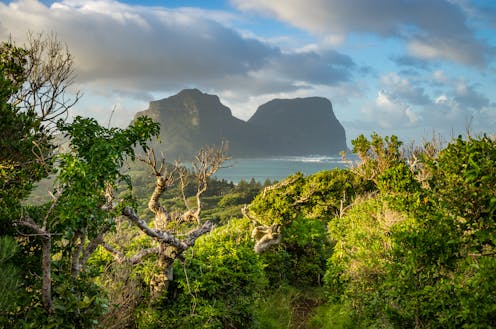
Some 70% of the World Heritage-listed Lord Howe Island has been closed to non-essential visitors in response to a recurrence of the plant disease myrtle rust.
Myrtle rust, native to South America, was first detected in Australia on the Central Coast of NSW in April 2010. It is caused by a fungus that belongs to a group of plant pathogens known as the rusts.
Rusts are among the most feared of all plant pathogens. They spread rapidly over thousands of kilometres on wind currents and can cause huge losses in plant production.
For example, wheat rust research over the past 100 years at the University of Sydney has shown clear evidence of wind-borne rust spores travelling from central Africa to Australia. Wheat production losses due to rust have at times totalled hundreds of millions of dollars.
Myrtle rust rapidly invaded the entire east coast of Australia in the years after it was first detected. It has caused the near extinction of at least three rainforest species, including the native guava (Rhodomyrtus psidioides) and the scrub turpentine (Rhodamnia rubescens).
The disease was detected at Lord Howe Island in 2016, and eradicated. Now it has managed to spread there once again. There are concerns if the disease is left unchecked, it could seriously alter the unique ecology of the island. Lord Howe is home to some 240 native plant species, of which more than 100 are not found anywhere else.

How can the disease be controlled?
Rust diseases in agriculture are controlled by the cultivation of genetically resistant plants, or by use of fungicides. These fungicides can kill existing recent infections and provide protection for up to four weeks. In other situations, such as horticulture and native plant communities, fungicides are used together with removal and destruction of infected plants.
The 2010 detection of myrtle rust in Australia followed its detection in Hawaii in 2005 and China in 2009. It was later found in New Caledonia (2013) and New Zealand (2017). Research has shown the same strain – known as the “pandemic strain” – has appeared in all of these countries. Several other strains occur in South America.
It is likely the fungus spread to Lord Howe Island from eastern Australia on wind currents. The especially wet conditions along the east coast of much of Australia in 2022 led to an increase in the disease there. This, in turn, increased rust spore load and hence the chance of long-distance spore dispersal.
Read more: Undocumented plant extinctions are a big problem in Australia – here’s why they go unnoticed
In addition to being spread on the wind, the rusty coloured spores produced by these fungal pathogens stick readily to clothing. These spores remain viable for at least two weeks under ambient conditions. Several wheat rusts of exotic origin are believed to have been accidentally brought in to Australia on travellers’ clothing from North America and Europe.
The chance of inadvertent spread of myrtle rust on contaminated clothing is why access to Lord Howe island has been restricted since last week.
The second incursion into the island clearly shows how incredibly difficult rust diseases are to manage once they reach a new region. It points to possible recurrences of the disease there in years to come even should current efforts to eradicate it succeed.
On top of the ability of rust diseases to spread rapidly over large distances, a further complication in controlling myrtle rust is it infects a wide range of native plants. Some of these species hold great cultural significance and/or are endangered.
Endemic species of the myrtle plant family Myrtaceae that are dominant in many of the plant communities on Lord Howe Island are highly vulnerable to myrtle rust infection. Of critical concern are two species that occur only on the island: the mountain rose (Meterosideros nervulosa) and the rainforest tree scalybark (Syzigium fullagarri). The rust infects young leaves and also flowers, where it causes sterility.
Australia brings expertise to the battle
Australia has some of the best plant pathologists in the world and has long been a leader in controlling rust diseases in agriculture. This expertise, combined with world-leading scientists in the ecology of Australian native plants, has enabled solid progress in understanding myrtle rust in the Australian environment. Australian scientists have joined hands with New Zealand scientists to boost efforts to control the pathogen in both countries.
Research is also under way at the University of Sydney and Australian National University to develop new DNA-based diagnostics to allow rapid identification of the different strains of the pathogen. These tests are especially important given only one strain of myrtle rust occurs in the Asia-Pacific and Oceania regions.
The success of managing the impact of myrtle rust on the region’s iconic flora against a backdrop of climate change will rely heavily on undertaking the research needed to gain a much better understanding of this damaging plant pathogen. Recognising this, staff at the University of Sydney have convened a conference for June 21-23 this year. It will bring together myrtle rust experts to exchange their latest research findings and identify priority areas for research.
Robert Park does not work for, consult, own shares in or receive funding from any company or organisation that would benefit from this article, and has disclosed no relevant affiliations beyond their academic appointment.
This article was originally published on The Conversation. Read the original article.







